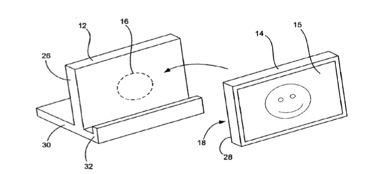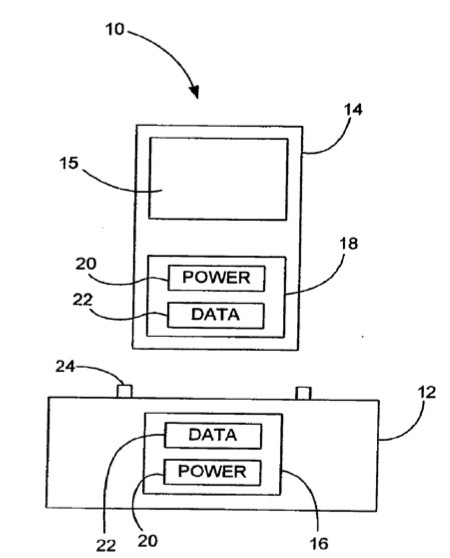A new Apple patent (number 20100177476) has popped up that shows the company is working on new dock connectors that would allow idevices such as the iPhone, iPod touch and iPad to be docked in either horizontal or landscape orientations.
The invention relates generally to docking stations for portable electronic devices. More particularly, the present invention relates to docking stations for portable electronic devices, which have planar like configurations and that operate in multiple orientations. Even more particularly, the present invention relates to improved techniques for transferring data and/or power between portable electronic devices and the docking stations.
The patent involves methods and apparatuses for docking a portable electronic device that has a planar like configuration and that operates in multiple orientations. The docking system includes a portable electronic device capable of operating in multiple orientations including vertical and horizontal. The docking system also includes a docking station configured to mechanically accept and operatively interface with the portable electronic device in any of its multiple orientations including vertical and horizontal. The inventors are Steve Hotelling and Gus Pabon.
Here's Apple's background and summary of the invention: "Any electronic devices include a docking station for providing a convenient interface for transferring data between the electronic device and other devices, such as a computers, speakers, monitors, and printers. The docking station may also include an interface for connecting to a power source so that the electronic device can be powered or charged (e.g., battery). In most cases, the docking stations include a cavity within which the electronic device is received. The cavity is configured to have a size and shape that coincides with the size and shape of the electronic device so that the electronic device rests snuggly within the cavity. Furthermore, the cavity typically includes a connector therein for operatively engaging a port of the electronic device when the electronic device is positioned within the cavity. The connector is typically coupled to the external systems (e.g., computer, power source) through a cable so that communications between the electronic device and the external systems can take place.
"Recently, inductive charging units have been implemented in electronic devices, the most famous of which is the Sonic Care toothbrush manufactured by Philips of the Netherlands. The toothbrush and the charging dock form the two part transformer with the primary induction coil contained in the dock and the secondary induction coil contained in the toothbrush. When the end of toothbrush is placed in a cavity of the dock, the complete transform is created and the induced current in the secondary coil charges the battery.
"Inductive charging pads have also been developed. The pad works similar to the toothbrush, however, the pad typically includes multiple transformers so that the electronic device can be placed in any orientation on the pad. When the electronic device is placed on the pad, one of the transformers of the pad induces current in the transformer of the electronic device, and this current charges the battery of the electronic device. Unfortunately, the efficiency of the transform is not very good since the transformer located on the electronic device typically does not align with the transformers of the pad, i.e., does not create closed magnetic loop and therefore there is no direct inductive coupling.
"The invention relates, in one embodiment, to a docking system. The docking system includes a portable electronic device capable of operating in multiple orientations including vertical and horizontal. The docking system also includes a docking station configured to mechanically accept and operatively interface with the portable electronic device in any of its multiple orientations including vertical and horizontal.
"The invention relates, in another embodiment, to a docking system. The docking system includes a portable electronic device having a front side and substantially planar back side opposite the front side and including a full screen display at the front side and a power transfer mechanism at the substantially planar back side. The full screen display is configured to display content in an upright manner whether the portable electronic device is used horizontally or vertically. The docking system also includes a docking platform having a substantially planar front side configured to support the substantially planar backside of the portable electronic device thereon, and including a power transfer mechanism at the substantially planar front side. The power transfer mechanism of the portable electronic device and power transfer mechanism of the docking platform are aligned along an axis and juxtaposed relative to one another when the portable electronic device is supported by the docking platform. The power transfer mechanism of the portable electronic device and the power transfer mechanism of the docking platform are rotationally symmetric about the axis such that they maintain communication with one another whether the portable electronic device is placed horizontally or vertically on the docking platform.
"The invention relates, in another embodiment, to a docking station. The docking station includes a platform that allows a substantially planar portable electronic device to be docked in multiple orientations about an axis. The docking station also includes an interface mechanism located at the platform and configured to interface with a corresponding interface mechanism of the portable electronic device when the portable electronic device is docked to the platform in any of its multiple orientations.
"The invention relates, in another embodiment, to a docking station. The docking station includes a substantially planar platform for receiving a substantially planar portable electronic device thereon. The substantially planar platform receives the portable electronic device in a plurality of orientations about an axis. The plurality of orientations includes at least a horizontal orientation and a vertical orientation. The docking station also includes an interface mechanism disposed in the substantially planar platform and having a center located at the axis. The interface mechanism communicates with a corresponding interface mechanism disposed in the substantially planar portable electronic device when the substantially planar portable electronic device is placed on the substantially planar platform in any of the plurality of orientations. The docking station further includes one or more alignment features for aligning a center of the corresponding interface mechanism of the substantially planar portable electronic device with the axis when the substantially planar portable electronic device is placed on the substantially planar platform in any of the plurality of orientations.
"The invention relates, in another embodiment, to a portable electronic device configured to operate in multiple orientations including horizontal and vertical orientations. The portable electronic device displays content in an upright manner in both the horizontal and vertical orientations. The portable electronic device has a substantially planar back side for placement on a planar front side of a docking platform in each of its multiple orientations. The portable electronic device includes an interface mechanism located at the back side of the portable electronic device and configured to interface with a corresponding interface mechanism located at the front side of the docking platform when the portable electronic device is placed on the docking platform in any of its multiple orientations."
Also appearing at the US Patent & Trademark Office today is Apple patent number 20100180063 for a serial pass-through device. It involves a host device and an accessory exchange information (e.g., commands and data) via an intermediate device. The host device and accessory can each connect to the intermediate device. The host device can exchange commands and data with the intermediate device, while the accessory device can serially exchange data with the intermediate device. The host device and the accessory can also "tunnel" information to each other through the intermediate device, by packaging the tunneled information as a payload of a command recognizable by the intermediate device; the intermediate device can repackage and forward the payload. In some embodiments, the intermediate device can control serial communication parameters between the intermediate device and the accessory in response to commands received from the host. The inventors are John Ananny, David S. Fisher, Peter Langenfeld and Scott Krueger.
-- Dennis Sellers














